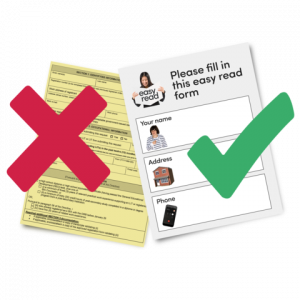2 December 2019
Easy Read – Top 10 FAQ’s
Many people are still unsure what Easy Read is or how to create it.
Below are some Frequently Asked Questions that our customers send us. We hope the information helps you better understand both Easy Read and your customers’ requirements.
If you don’t find an answer to your questions here just get in touch with us, we’d be happy to help:
Email: info@a2i.co.uk
Telephone: 01179 44 00 44
1. What is Easy Read?
Easy Read is a written format that makes information accessible and easy to understand for adults with a learning disability.
Easy Read documents are professionally adapted versions of the original document.
2. What makes Easy Read easy?
The words are simple, clear and understandable, and documents, paragraphs and sentences should be short. It’s important to use a positive tone of voice, to use an active tense, and to define any complicated words that can’t be avoided.
Pictures are used extensively throughout an Easy Read document. A picture is ideally inserted next to each sentence or paragraph of text, to support the reader to understand the wording used. It is best to use pictures featuring people with a learning disability where possible, as the reader will relate to them better.
Appropriate fonts and layout are chosen to make the document user-friendly and welcoming to read.
3. Who uses Easy Read and how should it be presented?
Easy Read documents are mainly designed for people with a learning disability.
It might also be helpful for other people who find it harder to process information.
Easy Read documents can either be printed or made available electronically (e.g. by email or online).
4. What are the benefits of providing my documents in Easy Read?
Easy Read leaflets are becoming more widely available on all sorts of topics, and are often provided on websites as an alternative to a standard document.
Remember: People with learning disabilities need access to all information, not just disability-specific information. They need to know about their health, work, education, transport, and their communities.
It is important to make sure your information is accessible to everyone who needs it and Easy Read documents can be a great way to help you make your services more accessible.
For your organisation Easy Read documents will:
- allow people with a learning disability to access your information and services
- demonstrate that your organisation is serious about communicating and engaging with your service users or customers
- help you meet your legal obligations (see question 7 below for more information about this)
For individuals, Easy Read documents will:
- allow people to access your information more independently
- enable people to make their own choices
- help adults with a learning disability engage more fully in activities and discussions
- provide a useful tool for support workers when working with individuals or groups.
5. How do I get my document put into Easy Read?
You could produce your own Easy Read but it can be complicated and time consuming. Plus, you’ll need access to photos appropriate for your document.
Alternatively, you could ask a commercial company to translate your document to Easy Read for you. They will be experts at the translation and will supply photos.
See question 9 for more information about working with A2i to get your document in Easy Read.
6. How much does Easy Read cost and how long does it take?
Price and turnaround time will vary depending on the company you use and the length and complexity of your document. As an example, A2i prices start from £90 and we usually take from 5 working days to complete your document translation.
7. What images should I use in an Easy Read document?
Images should help the reader understand the words. They are usually positioned on the left; with the sentence or paragraph they relate to adjacent on the right.
You might need images to explain a wide range of scenarios, for example objects, actions, events, types of people, and emotions.
Your images should be clear and easy to understand. It is best to avoid anything that could cause confusion or distraction, for example, unusual angles, artistic lighting, and multi-coloured or busy backgrounds.
If your images feature people it is best to use people with a learning disability where possible, as the reader will relate to them better.
There are various online photo libraries available. For a good range of images you’ll probably need to pay for a license. However, if your subject matter is very unusual, you could commission an artist or designer to produce bespoke images for you instead.
8. What does the law say about Easy Read?
The Equality Act 2010 says all organisations should make their services and information about their services accessible for disabled people as a ‘reasonable adjustment’.
Providing your documents in Easy Read would generally be seen as a reasonable adjustment if you are giving any written information to the public in general (of which some may have a learning disability), or for adults with a learning disability specifically.
Here’s a useful link about reasonable adjustments from the Equality and Human Rights Commission’s website.
9. How can I get a quote from A2i for Easy Read?
It is quick and easy to get a quote from us.
i) Send us your document and we’ll let you know our price and turnaround time. We’ll also ask you a few questions to make sure your Easy Read document is as relevant and user-friendly as possible.
ii) Just to our quote to confirm you’d like to go ahead, then sit back and relax. We will produce your Easy Read document and email it to you as quickly as possible. You can then review this first version and requests small amendments free of charge.
10. Should I get my Easy Read document checked by a user group?
Some organisations want this service, and others don’t. It will depend on who your Easy Read document is for, and it’s content.
Some organisation will have a checking group of their own. However, most organisations don’t have this and A2i can offer an independent checking service for you if needed.
A2i work with Mencap in Bristol and we can arrange for a group of adults with learning disabilities to check your Easy Read and suggest changes or improvements if appropriate. Just let us know if you’d like a quote for this extra service.
We regularly meet with this group ourselves, to get valuable feedback about Easy Read documents we have produced, or are in the process of creating.
More information about our Easy Read transcription service can be found on our Easy Read page.
Contact us at
Email: info@a2i.co.uk
Webform: a2i.co.uk/quote-request/
Telephone: 01179 44 00 44



